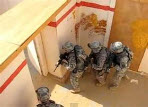Perceived Penalty For a Miss
A phrase that we often use in firearms training is the concept known as the “perceived penalty for a miss” (as in missed shot). This idea of the perceived penalty for a missed shot can apply to any scenario in which you use a firearm, be it home defense, self-defense while out and about, or even while shooting targets at the range. But for the context of this article, I will concentrate mainly on firearm use in home defense.
I am regularly on the lookout for news articles where firearms are used to save lives and protect property. I recently came across an article about a man who shot a home invader, but then ended up accidentally shooting his wife as well. This unfortunate incident clearly illustrates that in the course of defending our homes, not only are we responsible for the safety and protection of our families, but that we are also responsible for what happens as a result of our using deadly force as part of our home defense strategy.
Let me be perfectly clear about my own personal philosophy in this matter: Firearm ownership is an individual right that calls for individual responsibility. I do not endorse in any way, shape, or form the legislating of every single aspect of firearm ownership. Training, firearms storage, and safety are our individual responsibility as gun owners. We already have thousands of laws governing firearms ownership – we don’t need any more. They can’t even enforce the ones we have.
We are individually responsible for taking it upon ourselves to maintain marksmanship proficiency with our firearms, and being able to simultaneously and quickly think past the front sight of that firearm when we choose to engage a threat. In other words, we need to be able to quickly engage and stop a threat, as well as make sound decisions about that engagement based on risks and possible outcomes. Once that bullet leaves the muzzle, it can’t be called back. There will be consequences resulting from the defensive use of our firearm, and the final resting place of that bullet.
 Something that we emphasize in firearms training over and over, and that I also see very heavily emphasized in the advanced tactical training I have taken to keep up my own proficiency, is the idea that this concept of a penalty for a missed shot is very closely related to a fundamental firearms safety rule. The rule basically instructs you to know your target, know what is between you and the target, and know what is beyond your target. If you understand and apply that basic rule, you will better understand and apply good decisions based on the amount of perceived penalty in case you miss your target.
Something that we emphasize in firearms training over and over, and that I also see very heavily emphasized in the advanced tactical training I have taken to keep up my own proficiency, is the idea that this concept of a penalty for a missed shot is very closely related to a fundamental firearms safety rule. The rule basically instructs you to know your target, know what is between you and the target, and know what is beyond your target. If you understand and apply that basic rule, you will better understand and apply good decisions based on the amount of perceived penalty in case you miss your target.
Firearms and self-defense expert Rob Pincus of I.C.E. Training mentions that the perceived penalty for a miss translates to how worried you are that you will miss, or what happens if you miss. What happens if you miss can be a factor of where you are in relation to the threat, in relation to everything else. Are there other people, either seen or unseen, that can be in jeopardy? What is behind that threat? Can you move so that if you shoot at the threat, you shoot towards a more solid backstop where there is less of a chance of over-penetrating into a soft wall and hurting unknown people behind that wall? This is an example of how training is an important factor in helping with decision making and will be discussed in part 2 of this series. But I wanted to give an example of the types of things that come into play when thinking of the perceived penalty for a miss.
As I mentioned above, there will be consequences (outcomes), positive and negative, resulting from the use of deadly force in protecting your home. For all of the scenarios below, a violent criminal enters your home with the intent of doing you and your family harm. You are armed and intend to exercise your natural and legal right to defend your home. So let’s take a look at just a few of the possible outcomes.
Scenario 1: You engage the threat, your bullets hit their intended mark, and the threat is stopped. No other people are hurt or property damaged. The police come to investigate. You are found to be a victim of a home invasion who successfully and lawfully protected yourself and your loved ones.
Scenario 2: You engage the threat; your bullets hit their intended mark, but over penetrated and went through a wall. Or some of your bullets missed the bad guy altogether and went through an interior wall of your house. Another family member or pet may or may not have been on the other side of that wall – you didn’t know that when you fired the shot. You later find out that you also wounded a family member. The police come to investigate. You may or may not be charged with negligence, but you will forever be emotionally scarred knowing that you hurt someone you love.
Scenario 3: You engage the threat; you panic and shoot wildly hoping to hit the bad guy. Your shots miss and go through some interior walls and some outer walls of your house, go into a neighbor’s house, and wound a neighbor. The police come to investigate. You are found to have negligently discharged your firearm and are arrested to face possible charges.
 There are many other possible scenarios, and I won’t presume to know or report them all here. But the above illustrate just a few of the very real and possible outcomes. Again, minimizing risk while protecting your family member’s lives is what it’s all about. The ultimate goal is for your family to be safe, and NO lives put in jeopardy. Of course, when the criminal invader chose to enter your home and commit a violent crime, he or she made the decision that they were willing to take the risks of injury or death in doing so. That’s a risk mitigation that is out of your control. But what IS in your control is the ability to decide whether or not to engage the threat with deadly force, and if so to hit your intended target by building marksmanship and proficiency, and making sure that you know your target, what is between you and the target, and knowing what is beyond your target.
There are many other possible scenarios, and I won’t presume to know or report them all here. But the above illustrate just a few of the very real and possible outcomes. Again, minimizing risk while protecting your family member’s lives is what it’s all about. The ultimate goal is for your family to be safe, and NO lives put in jeopardy. Of course, when the criminal invader chose to enter your home and commit a violent crime, he or she made the decision that they were willing to take the risks of injury or death in doing so. That’s a risk mitigation that is out of your control. But what IS in your control is the ability to decide whether or not to engage the threat with deadly force, and if so to hit your intended target by building marksmanship and proficiency, and making sure that you know your target, what is between you and the target, and knowing what is beyond your target.
Now that you have an overview of the concept behind the “perceived penalty for a miss” and the background behind the thought processes for reducing this risk, we will now discuss getting back to basics and remembering the fundamentals of firearms safety. In particular, the rule of knowing your target plays a big part in minimizing the risk of causing harm to others in a defensive incident.
SHAMELESS DISCLAIMER: The strategies and scenarios depicted in this article are not all encompassing. There are many possible scenarios and strategies – I do not presume to know them all. Your own situation and environment will certainly vary, so you have to use common sense and be able to think through your strategy for yourself. In other words – everything you read here is based on opinion derived from my most diligent research possible, and my own ability to think critically. I am not responsible for other people’s inability to use common sense or sound decision making skills. I am not responsible for the actions taken by the readers of this article series.
So having said all that, here are some suggestions for reducing the risk that a missed shot may cause unintended harm. You need to think these through for yourself, and apply them in a way that makes sense for your own unique situations.
Know and APPLY The Fundamentals of Firearm Safety: Think about and constantly remember those basic rules you learned when you were first introduced to firearms. Then, actually APPLY those rules every time you handle firearms. Whether you are going to the range, carrying concealed while out and about, or just having a ready firearm to defend your home, you are responsible for applying these common sense rules. In case you need a refresher, here they are again:
-
Always assume that every gun is loaded
-
Always keep the muzzle pointed in a safe direction
-
Always keep your finger OFF of the trigger until ready to shoot
-
Always know your target, what is between you and the target, and what is beyond the target.
Know Your Home and What is Around Your Home: Think about all the possible places where a home invader will enter and travel throughout the home, as well as what they might be looking for. Think about where your family members will likely be in proximity to these places, and where you will be in the course of defending your home and stopping the attack. Walk through your house and think about each of the walls – what is behind those walls? Don’t forget floors and ceilings – what’s on the other side of those? A basement, a bedroom, a bathroom, or other frequently inhabited area? Think about those exterior walls. What’s on the other side? Are the houses in your neighborhood close together? Do you live in a townhouse or apartment with a neighbor just on the other side of that wall? What are the walls made of?
 Know Your Plan of Action: What will you and your family do if you hear or suspect a break-in or the intrusion alarm goes off? Can you all get to a safe room, or will family members be in areas scattered all throughout your home? Can you all stay barricaded in one place until the police arrive, or will you be forced to go on a “room clearing mission” so that you can secure other family members? “War Game” possible scenarios and think about how to get all of your family members to a safe room in case of an emergency. If that’s just not possible, then think of where you would position yourself in any of your rooms in case you have to shoot. Think of how you can reposition yourself in relation to the invader’s position in order to take a better and safer shot. You need to be aware of your entire home and environment in order to minimize the risk of a bullet missing and going into an area where people may be.
Know Your Plan of Action: What will you and your family do if you hear or suspect a break-in or the intrusion alarm goes off? Can you all get to a safe room, or will family members be in areas scattered all throughout your home? Can you all stay barricaded in one place until the police arrive, or will you be forced to go on a “room clearing mission” so that you can secure other family members? “War Game” possible scenarios and think about how to get all of your family members to a safe room in case of an emergency. If that’s just not possible, then think of where you would position yourself in any of your rooms in case you have to shoot. Think of how you can reposition yourself in relation to the invader’s position in order to take a better and safer shot. You need to be aware of your entire home and environment in order to minimize the risk of a bullet missing and going into an area where people may be.
Know Your Defensive Ammunition: Is the defensive ammunition that you use in your home defense strategy going to stop the threat, but also over-penetrate and go where you don’t want it to go? Now is the time to think about other types of ammunition that are possibly better choices for home defense, such as frangible or “safety slug” ammunition. Glaser Safety Slugs, for example, provide optimum penetration, yet fragment very quickly to prevent over penetration. These rounds are a popular home defense round, and are available in many common handgun and rifle calibers. Using a home defense shotgun with a shell containing non-lethal rubber balls as the first round, followed by rounds of bird shot or #4 buckshot is another popular choice. You have to decide what types of ammunition and home defense firearms you are comfortable with.
 Know and Constantly Improve Your Own Skills: Being proficient is a huge responsibility, and perhaps the most important of all of these strategies. Becoming highly proficient in firearms deployment for defensive uses may take a lot of your time, but the effort expended is beyond measure in its worth. Do you regularly practice your marksmanship? Do you regularly practice defensive skills such as drawing from a holster or shooting on the move? When was the last time you took advanced formal training beyond just the basics? Continuous training is extremely important. Maybe participate in IDPA or defensive pistol matches on a regular basis.
Know and Constantly Improve Your Own Skills: Being proficient is a huge responsibility, and perhaps the most important of all of these strategies. Becoming highly proficient in firearms deployment for defensive uses may take a lot of your time, but the effort expended is beyond measure in its worth. Do you regularly practice your marksmanship? Do you regularly practice defensive skills such as drawing from a holster or shooting on the move? When was the last time you took advanced formal training beyond just the basics? Continuous training is extremely important. Maybe participate in IDPA or defensive pistol matches on a regular basis.
Wrapping it All Up:
When it comes to missed shots, the consequences can be severe if one fails to adequately prepare. It is important to note that eliminating all risks is impossible, but one can certainly minimize them. This can be achieved by diligently preparing and using common sense in every action. Armed defense is undeniably an individual right; however, it also comes with great personal responsibility. Therefore, it is crucial to consistently practice, revisit the fundamentals, and strive for improvement. Familiarize yourself with the essential safety rules of gun handling, understand your surroundings, devise a plan, and master your equipment. By doing so, you can mitigate the risks associated with armed defense.

Visit my
LASR App
Referal
Agent Page
and Save 10%
on Your
Purchase:
Use Discount
Code
SDPATRIOT


